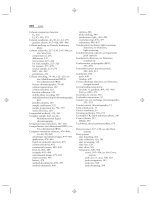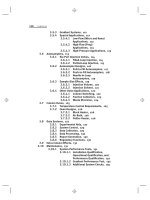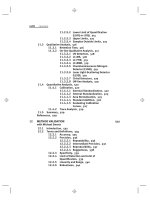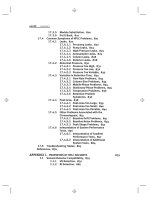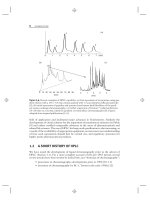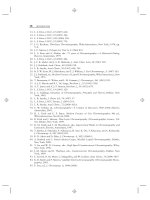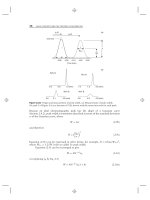Introduction to Modern Liquid Chromatography, Third Edition part 32 pptx
Bạn đang xem bản rút gọn của tài liệu. Xem và tải ngay bản đầy đủ của tài liệu tại đây (247.84 KB, 10 trang )
266 REVERSED-PHASE CHROMATOGRAPHY FOR NEUTRAL SAMPLES
mobile phases will often provide a better separation. This proved to be the case for
the present sample. A 1:1 blend of the mobile phases of Figure 6.8a (46% ACN)
and Figure 6.9a (61% MeOH) was prepared, and used to obtain the separation of
Figure 6.9b. The new mobile phase (containing 23% ACN + 30% MeOH) provides
baseline resolution (R
s
= 1.8).
(a)
(b)
S
“regular”
r
2
= 1.00
6
4
2
0
0246
log k
w
2
1
0
log k
%B (100f)
40 60 80
Figure 6.7 Variation of log k with %B for regular and irregular samples. (a )Regularsample(a
mixture of herbicides [24]), separated on a C
18
column with methanol-water as mobile phase
(see Fig. 2.6 for other conditions); (b)plotofvaluesofS versus log k
w
for data of (a); (c) irreg-
ular sample of Figure 6.6; conditions as in Figure 6.6; (d) plot of values of S versus log k
w
for
data of (c). (a, b) Adapted from [25].
6.3 SELECTIVITY 267
(d)
1 1.5 2.0 2.5 3.0
4.0
3.5
3.0
2.5
2.0
S
log k
w
“irregular”
r
2
= 0.87
(c)
%B (100f)
0 10203040506070
2.0
1.5
1.0
0.5
0.0
1
2
3
4
5
6
7
8
log k
Figure 6.7 (Continued)
While the separation of Figure 6.9b is much improved, further variation in the
proportions of mobile phase from Figure 6.8a (46% ACN) and Figure 6.9a (61%
MeOH) may provide some more resolution. Peaks 1 to 4 in Figure 6.9b are less
resolved than remaining peaks 5 to 10 (i.e., peaks 1–4 are ‘‘critical’’), so we will
limit our discussion to these peaks. Figures 6.10a–c replicate earlier chromatograms
for peaks 1 to 4 from Figures 6.8 and 6.9, for changes in the relative proportions
of ACN and MeOH. As MeOH replaces ACN in going from Figure 6.10a–c,it
is seen that peaks 2 and 3 (shaded) move toward the front of the chromatogram.
In Figure 6.10b (1:1 blend of mobile phases from Fig. 6.10a,c), the critical (least
resolved) peak-pair is 2/3, and we can improve its resolution by a further movement
268 REVERSED-PHASE CHROMATOGRAPHY FOR NEUTRAL SAMPLES
0 2 4 6 8 10 12 14
Time (min)
1
2
3
+
4
5
7
8
9
10
6
(a)
46% ACN
1.1 ≤ k ≤ 4.6
R
s
= 0.0
0
20
40
Time (min)
1
2
+
3
+
4
5
6
7
8
9
10
(b)
34% ACN
2 ≤ k ≤ 14
R
s
= 0.3
Figure 6.8 Separation of a mixture of substituted benzenes as a function of solvent
strength (%B). Sample: 1, p-cresol; 2, benzonitrile; 3, 2-chloroaniline; 4, 2-ethylaniline; 5,
3,4-dichloroaniline; 6, 2-nitrotoluene; 7, 3-nitrotoluene; 8, toluene; 9,3-nitro-o-xylene; 10,
4-nitro-m-xylene. Conditions: 250 × 4.6-mm (5-μm) C
8
column; acetonitrile–pH-6.5 buffer
mobile phase; 35
◦
C; 1.0 mL/min. Chromatograms recreated from data of [26]. Note that all
compounds are non-ionized under these condition, so the sample is effectively neutral.
0 2 4 6 8 10 12
14
Time
(
min
)
1
2
3
4
5
6
7
8
9
10
(b)
30% MeOH + 23% ACN
1 ≤ k ≤ 4
R
s
= 1.8
Time (min)
0246810
1
2
3
4
5
6
7
8
9
10
(a)
61% MeOH
0.8 ≤ k ≤ 3.0
R
s
= 0.6
Figure 6.9 Solvent-type selectivity. Separation of a mixture of substituted benzenes with
methanol or mixtures of methanol-acetonitrile as mobile phase. Same sample and conditions
as in Figure 6.8, except as noted in figure. Chromatograms recreated from data of [26].
of peak 2 away from peak 3 and toward peak 1. This can be achieved by increasing
the proportion of MeOH in the final mobile phase (with respect to the mobile
phase of Fig. 6.10b). As seen in Figure 6.10d, a mixture of 57% Figure 6.10c (61%
MeOH) and 43% Figure 6.10a (46% ACN) positions peak 2 midway between peaks
1 and 3 for maximum resolution (R
s
= 2.0vs.R
s
= 1.8 in Fig. 6.10b). Achieving
an optimum final separation in this example involves simple interpolation between
6.3 SELECTIVITY 269
4
6
Time (min)
1
2
4
3
(c)
61% MeOH
0.8 ≤ k ≤ 3.0
R
s
= 0.6
6
Time (min)
1
2
3
4
(d)
57/43 mixture of (c) and (a)
1 ≤ k ≤ 4
R
s
= 2.0
4
6
(a)
46% ACN
1.1 ≤ k ≤ 4.6
R
s
= 0.0
Time (min)
1
2
3
+
4
6
Time (min)
(b)
50/50 mixture of (a) and (c)
(30% MeOH + 23% ACN)
1 ≤ k ≤ 4
R
s
= 1.8
1
2
3
4
Figure 6.10 Solvent-type selectivity: fine-tuning the B-solvent. Same sample and conditions as
in Figures 6.8 and 6.9 (peaks 1–4 only), plus added figure (d); (b) is 30% MeOH + 23% ACN,
and (d) is 35% MeOH + 20% ACN. Chromatograms recreated from data of [26].
the two preceding experiments (Fig. 6.10b,c), much like the example of Figure 6.6
where %B was optimized. Similar optimizations of selectivity can be carried out
more conveniently by the use of computer simulation (Chapter 10).
Although improvements in resolution may be explored by changing the
B-solvent (solvent-type selectivity), the new mobile phase must have a similar
solvent strength in order to maintain comparable values of k and run time. In
Figure 6.9a, a higher %-MeOH was used (61% vs. 46% ACN) because methanol is
a weaker (more retentive) B-solvent than acetonitrile. When changing solvent type,
we can estimate the necessary change in %B for the new B-solvent by means of the
solvent nomograph of Figure 6.11. Here similar %B values for different B-solvents
fall on vertical lines. Recall that in the previous example we needed to replace 46%
ACN with a similar strength MeOH-water mobile phase. From the diagram of
Figure 6.11, we see that 46% ACN should be about equivalent in strength to 57%
MeOH (each of these two mobile phases is marked by
•
in Fig. 6.11); this is close to
the mobile phase actually selected in Figure 6.9a (61% MeOH). Note that the run
time in Figure 6.9a (11 min) is somewhat shorter than that in Figure 6.8a (15 min),
270 REVERSED-PHASE CHROMATOGRAPHY FOR NEUTRAL SAMPLES
100%
100%
100%
0 102030405060708090
0102030405060708090
0
20 30
40 50 60
70 80 90
THF/H
2
O
MeOH/H
2
O
ACN/H
2
O
Figure 6.11 Solvent-strength nomograph for reversed-phase HPLC (adapted from [28]). Two
mobile phases of equal strength (46% ACN and 57% MeOH) marked by
•
,asanexample.
as could be expected from Figure 6.11; that is, 61% MeOH is stronger than the
57% MeOH recommended by Figure 6.11.
To summarize, when using a change in solvent type to change selectivity and
increase resolution, proceed as follows: If ACN was used in the initial separation, and
MeOH is to be substituted, Figure 6.11 shows how to estimate the best %-MeOH for
use in the second separation. Next examine the ACN and MeOH chromatograms to
determine if a mixture of ACN and MeOH is likely to give a better separation than
either B-solvent alone (as in Fig. 6.9b). Conditions can be improved as illustrated
by Figure 6.10 and discussed further in Section 6.4.1. If MeOH was used initially
as the B-solvent, use Figure 6.11 to estimate the equivalent % ACN for a change in
B-solvent without affecting the solvent strength.
Solvent-type selectivity arises from interactions among solute, B-solvent, and
column, as described in Sections 2.3.2.1 and 5.4.1. The preferential retention of
the B-solvent in the stationary phase means that a stronger interaction of the
B-solvent and solute will normally lead to increased retention (this may at first seem
counterintuitive, in terms of the discussion of Fig. 2.7a,b). However, even qualitative
predictions of the effect of a given B-solvent on the relative retention of different
solute classes (e.g., phenols, ethers) are difficult at best. For further discussion,
see [23].
6.3.3 Temperature Selectivity
Retention as a function of temperature can usually be described by
log k = A +
B
T
K
(6.2)
where A and B are constants for a given compound when only the absolute
temperature T
K
(K) is varied. Plots of log k versus 1/T
K
should therefore yield
straight lines, as in Figure 6.12a for a number of polycyclic aromatic hydrocarbons
(PAHs). An increase in column temperature by 1
◦
C usually results in a decrease
in values of k by 1–2% for each peak in the chromatogram [29]. The effect of
a change in temperature on selectivity is usually minor for the RPC separation of
neutral samples. However, exceptions have been noted, as in the case of PAHs [30]
and plant pigments [31]. Figure 6.12b is an extension of Figure 6.12a,withdatafor
three additional PAHs (dashed curves A–C); compounds 1 to 6 are flat, fused-ring
6.3 SELECTIVITY 271
1.0
0.5
3.2 3.4 3.6
1000/T
K
45°C35°C25°C15°C
6
5
4
3
2
1
A
B
C
log k
22°C
1.0
0.5
3.2 3.4 3.6
1000/T
K
45°C35°C25°C15°C
6
5
4
3
2
1
log k
(a)
(b)
Figure 6.12 Retention of polycyclic aromatic hydrocarbons as a function of separation tem-
perature. Conditions: 250 × 4.6-mm (5-μm) Chromegabond-C
18
column; 80% ACN-water;
1.0 mL/min. (a) Sample (fused-ring aromatic hydrocarbons): 1, anthracene; 2, fluoranthene; 3,
triphenylene; 4, chrysene; 5, 3,4-benzofluoranthene; 6, 1,2,5,6-dibenzoanthracene. (b) Sam-
ple same as (a), plus added poly-aryls: A,1,1
,-dinaphthyl; B, 1,3,5-triphenylbenzene; C,
9,10-diphenylanthracene. Adapted from [30].
PAHs such as anthracene (peak 1), while compounds A to C are three-dimensional
(nonflat) poly-aryls such as 1,1
,-dinaphthyl (peak A). It is seen that retention
reversals (marked by
•
) occur in Figure 6.12b for five adjacent peak-pairs as
temperature is varied between 15 and 45
◦
C. (Note the
◦
C scale at top of figure): B/5
at 42
◦
C, A/3 at 36
◦
C, C/6 at 31
◦
C, B/4 at 16
◦
C, and C/5 at 6
◦
C. In this example
there are major changes in selectivity as temperature is varied. As a result several
272 REVERSED-PHASE CHROMATOGRAPHY FOR NEUTRAL SAMPLES
temperatures exist between 10 and 70
◦
C where baseline resolution (R
s
≥ 1.5) is
possible, for example, a temperature of 22
◦
C, as shown in Figure 6.12b by a vertical
dotted line.
Changes in resolution with temperature for this sample are better seen in the
resolution map of Figure 6.13a: a plot of critical resolution as a function of temper-
ature. The resolution map of Figure 6.13a is enhanced in Figure 6.13b,toprovide
additional insight into this very useful tool. Thus potentially critical peak-pairs (e.g.,
B/4, C/6, A/3) that correspond to different line segments in Figure 6.13a are identified
in Figure 6.13b. Similarly arrows in Figure 6.13b indicate four temperatures where
baseline resolution (R
s
≥ 1.5) is possible. Resulting separations for the latter four
preferred temperatures are shown in Figures 6.13c–f (note the changed retention
order in each of these examples). The three poly-aryls A–C (shaded peaks) are seen
to be retained more strongly at higher temperatures relative to the fused-ring PAHs
1–6 (see the further discussion of following Section 6.3.3.1). The best separation
(R
s
= 2.1) is provided by a temperature of 22
◦
C. While changes in temperature
sometimes can be effective in altering separation selectivity for neutral samples,
changes in selectivity with temperature are much more likely for partly ionized acids
or bases (Section 7.3.2.2). For a further discussion of temperature selectivity in RPC,
see [32, 32a].
6.3.3.1 Further Observations
The following treatment provides a more complete picture of temperature selectivity
for neutral samples. However, the reader may prefer to skip this discussion and
continue with Section 6.3.4.
While Equation (6.2) is generally an adequate representation of RPC retention
as a function of temperature, more complex changes in k with temperature are
sometimes observed [7, 33–35]. Sometimes kincreaseswhen the temperature is
increased, or plots of log k versus 1/T may be curved instead of linear. These
exceptions to Equation (6.2) are often associated with acidic or basic solutes and a
mobile phase pH that is close to the pK
a
value of the solute (see Section 7.2). In such
cases a change in temperature may result in a change in the relative ionization of
an acid or base (Section 7.2.3), with a large resulting change in solute retention—in
addition to (and sometimes opposing) the normal effect of temperature that is
described by Equation (6.2).
The dependence of log k on temperature is determined by the value of B in
Equation (6.2), which is proportional to the enthalpy of retention, H.Values
of B usually increase for larger values of k; as a result plots of log k versus 1/T
for different solutes (other conditions the same) often resemble the fan-shaped
plots of Figure 6.12a for several fused-ring PAHs. The latter behavior can be
compared with the similar example of Figure 6.7a forregularsamplesas%Bis
varied; in both cases (change in %B or T) a change in condition has the largest
effect on k for the most retained solute (with the largest values of k). For most
neutral samples, changes in retention order with temperature are not expected
(asobservedinFig.6.12a), but maximum resolution may still be observed at an
intermediate temperature. However, a change in temperature is generally less useful
for improving the resolution of neutral samples (similar to the case of ‘‘regular’’
samples and solvent-strength selectivity).
6.3 SELECTIVITY 273
As noted in Figure 6.12b, values of B tend to be relatively smaller for more com-
pact molecules such as phenylnaphthalene (a poly-aryl), compared to less compact
molecules such as anthracene (a fused-ring PAH). Similar temperature-selectivity
effects have been observed for gas chromatography [36], where values of B in
Equation (6.2) decrease in the order n-alkynes
>
n-alkanes
>
branched alkanes
>
cycloalkanes. That is, values of B in GC also decrease for less extended, more
compact molecule—possibly for similar reasons.
6.3.4 Column Selectivity
During the early days of HPLC, a change of column was often used as a means of
varying selectivity and improving resolution. Indeed column selectivity represents
a powerful means for altering relative retention and improving the separation of
neutral samples. However, the use of column selectivity alone for the purpose of
systematically improving separation has a serious limitation, compared to changes
in %B, solvent type, or temperature. When any of the latter conditions are varied,
2.0
1.0
0.0
R
s
10 20 30 40 50 60 70
T (°C)
R
s
= 1.5
B/4
C/5
A/3
C/6
A/3
B/5
A/4
B/6
2.0
1.0
0.0
R
s
10 20 30 40 50 60 70
T (°C)
(a)
(b)
3/4
A/4
Figure 6.13 Separation of polycyclic aromatic hydrocarbons as a function of temperature.
Sample and conditions of Figure 6.12. (a, b) resolution map; (c–f ) chromatograms for differ-
ent optimum temperatures. Adapted from [30].
274 REVERSED-PHASE CHROMATOGRAPHY FOR NEUTRAL SAMPLES
024681012
02 0
02 0 40
024681012
Time (min)
Time (min)
Time (min)
Time (min)
T = 11°C
R
s
= 1.9
T = 22°C
R
s
= 2.1
T = 46°C
R
s
= 1.7
T = 61°C
R
s
= 1.7
(c)
(d)
(e)
(f)
1
2
A
3
B
4
5
C
6
1
2
A
3
4
B
5
C
6
1
2
3
A
5
B
6
C
1
2
3
4
A
5
6
B
C
4
10 30
14 16
Figure 6.13 (Continued)
continuous changes in selectivity are possible, and there will often be an intermediate
condition that corresponds to maximum resolution. In the examples of Figure 6.13,
this greatly increased the likelihood of an acceptable separation, compared to the
use of only one or two arbitrary temperatures. When the column is changed, the
selection of an intermediate separation (between that provided by either column) is
inconvenient. As a result a change in just the column is less likely to result in an
improved separation (but see the further discussion of Section 6.4.1.4). Changes in
the column are also less convenient than changes in continuous variables.
Examples of a change in selectivity when only the column is changed are
shown in Figure 6.14 for a 10-component neutral sample and four columns of
varying selectivity. Despite significant changes in selectivity for this sample when
the column is changed, no single column provides a resolution of R
s
>
0.8, as long
as other conditions remain fixed (as in this example). If two different columns are
connected together, additional separation possibilities are created, but this procedure
6.3 SELECTIVITY 275
Time (min)
Symmetry C18
1.6 ≤ k ≤ 19, R
s
= 0.4
1
2
3
4
5
+
6
7
8
9
(a)
10
0 2 4 6 8 10121416
1 ≤ k ≤ 7, R
s
= 0.4
Alltima HP C18 amide
Time (min)
1
3
2
+
4
5
7
6
8
9
+
10
(b)
0246
1 ≤ k ≤ 11, R
s
= 0.8
Luna phenyl-hexyl
Time (min)
1
2
3
4
5
6
7
8
10
9
(c)
0246810
1 ≤ k ≤ 14, R
s
= 0.0
Spherisorb ODS-2
Time
(
min
)
2
4
5
6
7
1
8+ 9
10
3
(d)
024681012
Figure 6.14 Separation of a mixture of 10 organic compounds of diverse structure on four
different columns. Sample: 1, 4-nitrophenol; 2, 5,5-diphenylhydantoin; 3, acetophenone; 4,
benzonitrile; 5, 5-phenylpentanol; 6,anisole;7, toluene; 8, cis-chalcone; 9, ethylbenzene; 10,
trans-chalcone. Conditions: 150 × 4.6-mm (5-μm) columns; 45% acetonitrile-water; 35
◦
C;
2.0 mL/min. Chromatograms recreated from data of [8, 9].
is inconvenient and only marginally better than the use of a single column (in the
example of Fig. 6.14, no combination of these four columns can improve the
separation of Fig 6.14c). The real advantage of a change in column selectivity is only
achieved when a change in column is accompanied by a simultaneous change in one
or more other conditions, for example, %B, solvent type, and/or temperature for
the case of neutral samples (Section 6.4.1.4).
